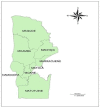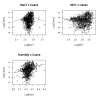Spatial and temporal patterns of malaria incidence in Mozambique
- PMID: 21752284
- PMCID: PMC3161914
- DOI: 10.1186/1475-2875-10-189
Spatial and temporal patterns of malaria incidence in Mozambique
Abstract
Background: The objective of this study is to analyze the spatial and temporal patterns of malaria incidence as to determine the means by which climatic factors such as temperature, rainfall and humidity affect its distribution in Maputo province, Mozambique.
Methods: This study presents a model of malaria that evolves in space and time in Maputo province-Mozambique, over a ten years period (1999-2008). The model incorporates malaria cases and their relation to environmental variables. Due to incompleteness of climatic data, a multiple imputation technique is employed. Additionally, the whole province is interpolated through a Gaussian process. This method overcomes the misalignment problem of environmental variables (available at meteorological stations--points) and malaria cases (available as aggregates for every district--area). Markov Chain Monte Carlo (MCMC) methods are used to obtain posterior inference and Deviance Information Criteria (DIC) to perform model comparison.
Results: A Bayesian model with interaction terms was found to be the best fitted model. Malaria incidence was associated to humidity and maximum temperature. Malaria risk increased with maximum temperature over 28 °C (relative risk (RR) of 0.0060 and 95% Bayesian credible interval (CI) of 0.00033-0.0095) and humidity (relative risk (RR) of 0.00741 and 95% Bayesian CI 0.005141-0.0093). The results would suggest that additional non-climatic factors including socio-economic status, elevation, etc. also influence malaria transmission in Mozambique.
Conclusions: These results demonstrate the potential of climate predictors particularly, humidity and maximum temperature in explaining malaria incidence risk for the studied period in Maputo province. Smoothed maps obtained as monthly average of malaria incidence allowed to visualize months of initial and peak transmission. They also illustrate a variation on malaria incidence risk that might not be related to climatic factors. However, these factors are still determinant for malaria transmission and intensity in the region.
Figures




References
-
- National Malaria Control Programme. Republic of Mozambique, Maputo 2007
-
- Banerjee S, Carlin BP, Gelfand AE. Hierarchical modelling and analysis for spatial data. Chapman and Hall, New York; 2004.
Publication types
MeSH terms
LinkOut - more resources
Full Text Sources
Medical

